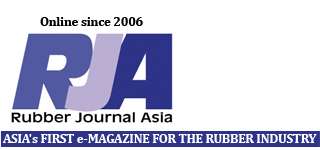THAILAND – Many farmers, lured by hearty annual returns of 800,000 baht per 20 rai, have abandoned rice for rubber farming across the North, Northeast and East.
Some formerly debt-ridden landowners have been able to pay off their loans after a year or two of growing rubber trees and saved enough to buy a car, build a house and send their children to university.
However, experts have warned this newfound prosperity is totally dependent on the global demand for rubber. The invention of an artificial substitute could spell disaster for rubber enterprises.
Despite such concerns, rubber plantations have continued to expand and this year the government targets an increase of 800,000 rai. The country had 12 million rai of rubber trees in 2008.
As many new farms enter the sector, quality saplings have become a precious commodity.
Soil is used to fill small bags into which the seedlings are transferred and allowed to grow before they can be distributed for planting in farms and plantations.
Jettaporn Sangthong, manager of the Rubber Cooperatives Phayao in the northeastern province, said the answer to top-grade saplings is in their roots.
Known as “budding” saplings, the young trees grow from seeds which ensure they contain tap roots. The seedlings then go through propagation by means of budding or grafting.
Conventionally, many growers prefer saplings obtained from stem cuts because these are produced in mass quantities in a relatively short period of time.
The budding shoots, on the other hand, take longer to grow, but Mr Jettaporn insisted it is worth the wait.
“These seedlings come with tap roots and they will produce a new generation of strong trees,” he said.
By comparison, the stem-cut saplings are weaker and tend to wilt quickly if they are not well taken care of.
The RCP has set aside three plots of land for growing the seedlings in Phayao and Chiang Rai. Together the plots span over 250 rai, churning out more than 4 million seedlings a year.
The budding seedlings require a meticulous growing process.
First, rubber seeds are buried in the specially prepared, moist soil. Once a shoot, or sporophyte, develops out of the seed, it is individually bagged.
The seedlings are then transferred, with the bags intact, into the soil. The bags ensure a constant feed of moisture.
The seedlings are left for six months before they are ready for grafting. About 60 days after grafting, the seedlings are ready to be planted on the farms.
Mr Jettaporn explained that the best seeds are taken from trees that are at least 20 years old. The best time for growing the seedlings is during the rainy season. Seedlings with tap roots mature faster than those from stem cuts. The trunks are also stronger and will not snap easily in high winds.
But most important of all, Mr Jettaporn said, the latex-yielding lifespan of trees from budding seedlings is longer than those from stem cuts.
Environment-wise, tap roots also help hold the soil together, preventing wind erosion and landslides.
Chutiwat Chaidarun, 37, a grower in Thoeng district of Chiang Rai, said in the past rubber farming was completely foreign to northern people.
But after the trees were introduced many years ago, farmers slowly mastered the skills to grow them.
In the beginning they mostly acquired stem-cut saplings and it was not until much later that they learned tap-root seedlings were a better alternative.
Mr Jettaporn said the growers should choose their saplings wisely – the inherent characteristics of the saplings relate directly to the quality of mature trees.
He noted many businesses have entered the rubber seedling production market, lowering the price for young trees, which is good news for farmers but not for sapling sellers. Although there appears to be an oversupply of mostly stem-cut saplings, tap-root seedlings remain very much sought-after.
Saman Buajoy, 68, a rubber farm owner in Chiang Kham district of Phayao, said that today there are not enough tap-root seedlings in the North.
This is because most of the rubber trees were introduced to the North less than 10 years ago, making them too young to bear quality seeds.
Tap-root rubber trees are also naturally more resistant to pests and fungus, helping farmers cut back on chemicals.
“It’s quite encouraging to us that we are not polluters. There’s no chemical residue left to be washed into the water supply,” Mr Saman said.
Rubber is being promoted as a cash crop in Phayao, which is establishing itself as a centre for rubber sheet production in the North.
Phayao governor Phongsak Wangsamer said the province has about 200,000 rai of rubber farms, mostly in Chiang Kham and Phu Sang districts.
At least 30 million baht is being spent on the construction of a rubber sheeting and smoking centre in Phu Sang district.
The governor said rubber growers in the province are getting together and setting up a cooperative which will strengthen their negotiating power.
The rubber-growing provinces in the North are strategically located close to Chiang Rai’s Chiang Saen port from which point the rubber can be exported to buyers in China.
Source: Chiangrai Times
